parking brake FORD EXPEDITION 1997 1.G Owners Manual
[x] Cancel search | Manufacturer: FORD, Model Year: 1997, Model line: EXPEDITION, Model: FORD EXPEDITION 1997 1.GPages: 224, PDF Size: 2.2 MB
Page 9 of 224

Brake system warning
Extinguishes when the parking
brake is released. Illumination after
releasing the parking brake
indicates low brake fluid level.
Safety belt
Illuminates when the ignition is
switched on to remind you to
fasten your safety belts. For more
information, refer toUsing the
safety restraints properlyin the
Seating and safety restraints
chapter.
Air bag readiness
Briefly illuminates when the
ignition is turned to On. If the light
fails to illuminate, continues to
flash or remains on, have the
system serviced. For more
information, refer to
Supplemental restraints system
(SRS)in theSeating and safety
restraintschapter.
Check engine warning light
This light illuminates when the
engine's Emission Control System
requires service. It will also
illuminate when the ignition key is
in the On position and the engine
is off. Refer toWhat you should
know about the On-board
diagnostic (OBD II) systemin the
Maintenance and carechapter.
!
BRAKE
CHECK
ENGINE
com_safety_belt.01
exd_air_bag
exd_check_engine
exd_tcil_light
Instrumentation
10
Page 20 of 224
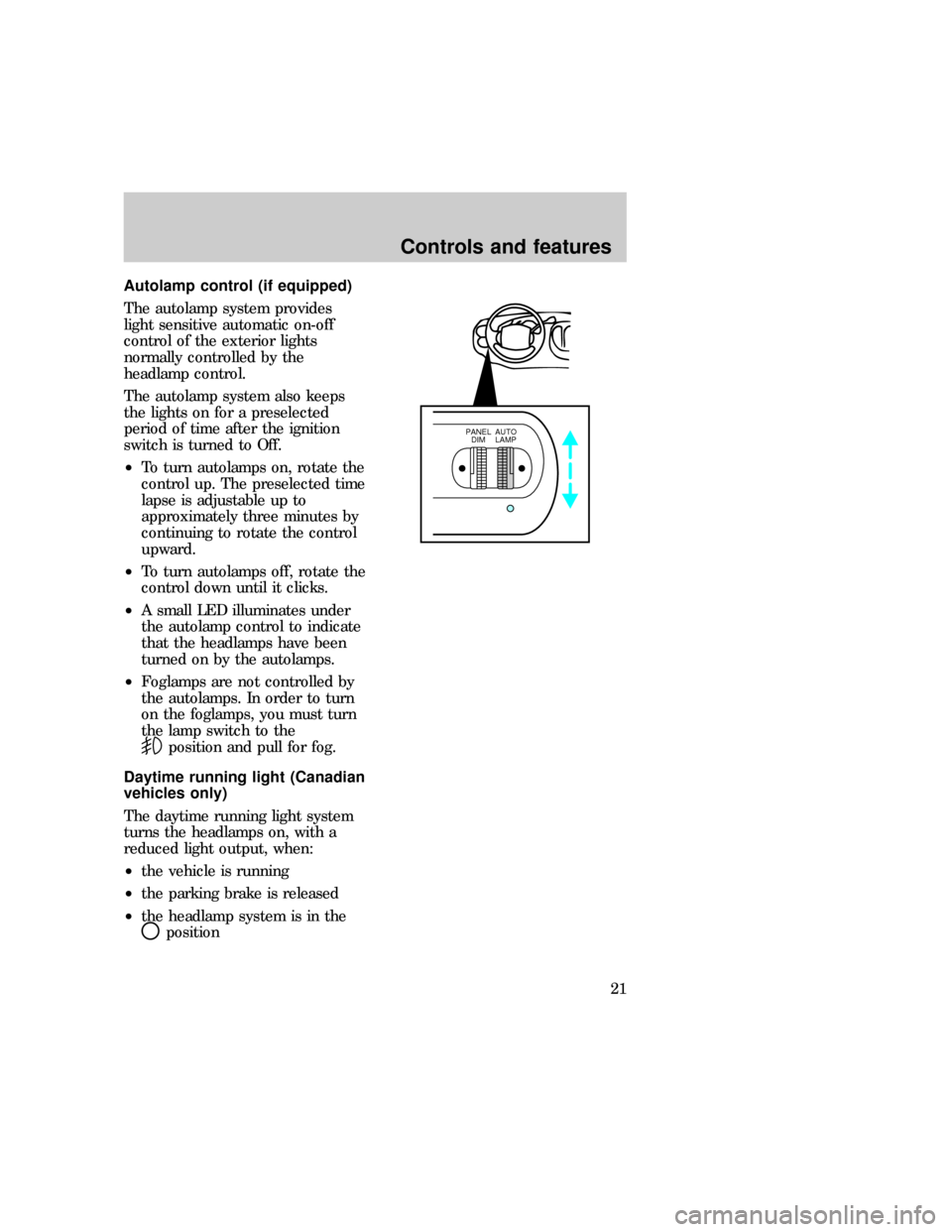
Autolamp control (if equipped)
The autolamp system provides
light sensitive automatic on-off
control of the exterior lights
normally controlled by the
headlamp control.
The autolamp system also keeps
the lights on for a preselected
period of time after the ignition
switch is turned to Off.
²To turn autolamps on, rotate the
control up. The preselected time
lapse is adjustable up to
approximately three minutes by
continuing to rotate the control
upward.
²To turn autolamps off, rotate the
control down until it clicks.
²A small LED illuminates under
the autolamp control to indicate
that the headlamps have been
turned on by the autolamps.
²Foglamps are not controlled by
the autolamps. In order to turn
on the foglamps, you must turn
the lamp switch to the
position and pull for fog.
Daytime running light (Canadian
vehicles only)
The daytime running light system
turns the headlamps on, with a
reduced light output, when:
²the vehicle is running
²the parking brake is released
²the headlamp system is in the
position
PANEL
DIMAUTO
LAMP
exd_drl
Controls and features
21
Page 25 of 224

Rear window defroster
Press the defroster control to clear
the rear window of thin ice and
fog.
²The small LED will illuminate
when the defroster is activated.
The ignition must be in the ON
position to operate the rear
window defroster.
The defroster turns off
automatically after 10 minutes or
when the ignition is turned to the
OFF position. To manually turn off
the defroster before ten minutes
have passed, push the control
again.
P
exd_parking_brake_location
Controls and features
26
Page 26 of 224
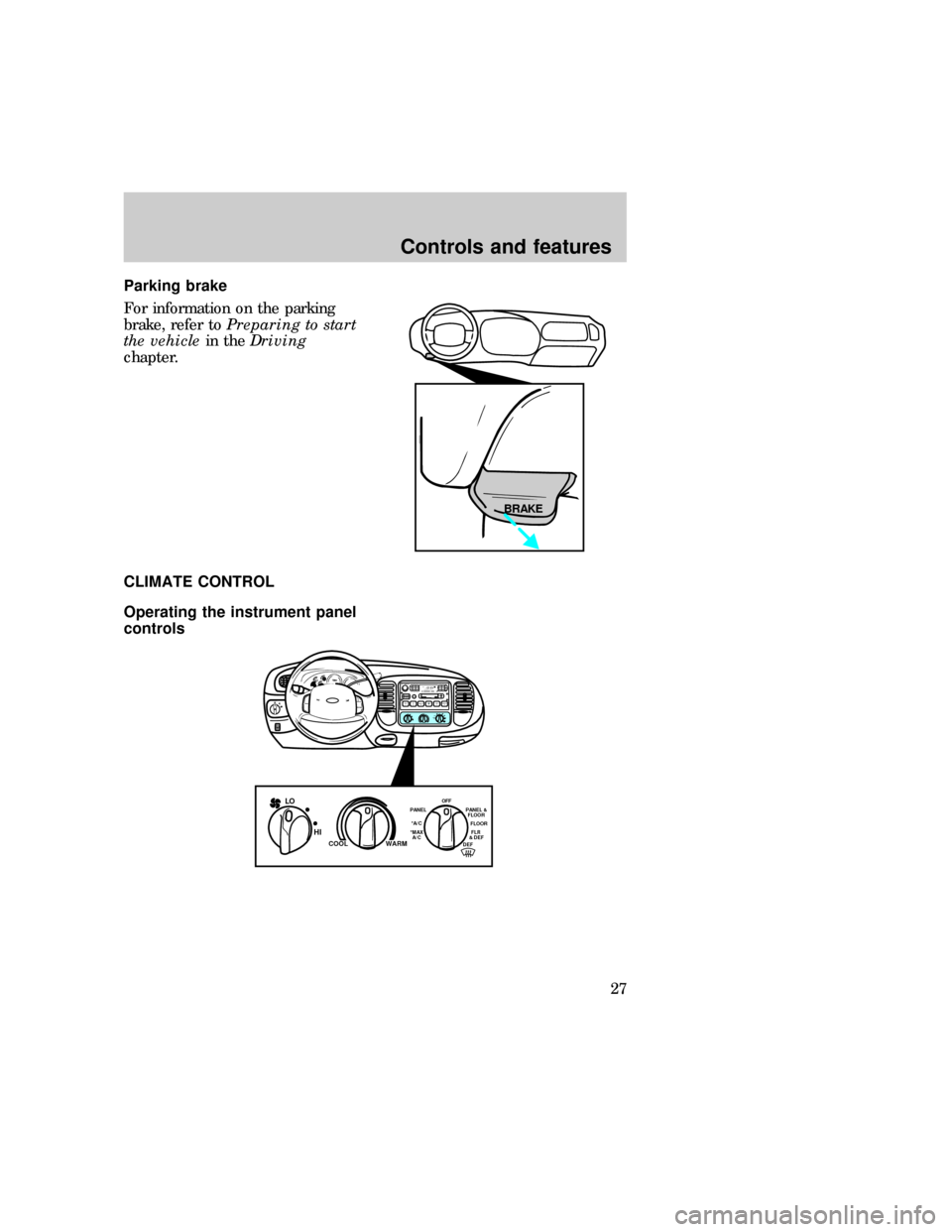
Parking brake
For information on the parking
brake, refer toPreparing to start
the vehiclein theDriving
chapter.
CLIMATE CONTROL
Operating the instrument panel
controls
BRAKE
PHI LOOFF*A/C*MAX
A/CREW
1FF
2SIDE 1-2
3
FM 1STVOL – PUSH ON
AM
FMBASS TREBBAL FADE
AUTO
SET CLKSEEKTUNE
DISCSSCAN4DOLBY SYSTEMEJTAPE CDCOMP5SHUFFLE
6
FLR
& DEF *MAX
A/CFLOOR PANEL &
FLOOR
DEF OFF
PANEL
*A/CWARM COOL
LO
HI
exd_climate_overview_art
exd_title_climate_controls
exd_vents_climate_controls
Controls and features
27
Page 101 of 224
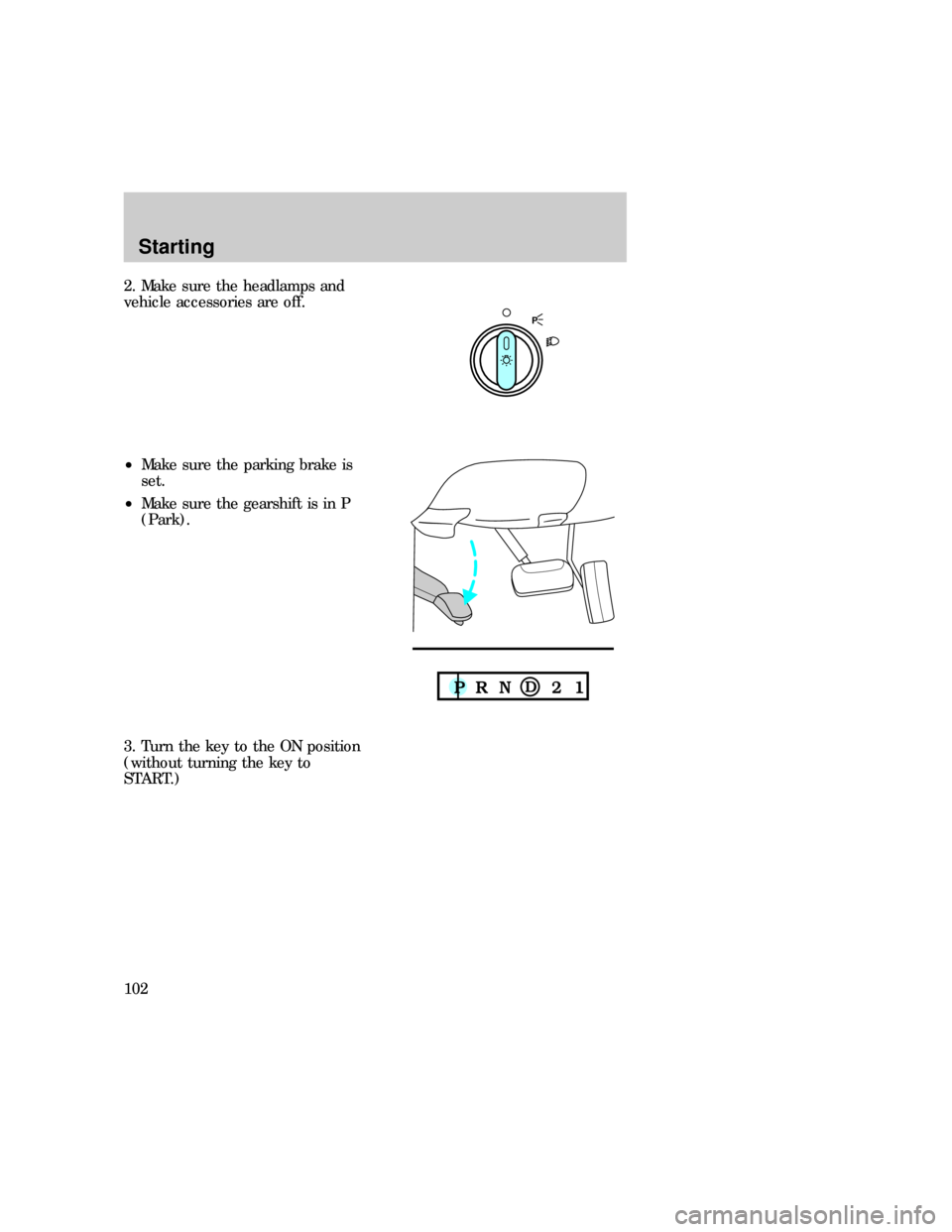
2. Make sure the headlamps and
vehicle accessories are off.
²Make sure the parking brake is
set.
²Make sure the gearshift is in P
(Park).
3. Turn the key to the ON position
(without turning the key to
START.)
P
Starting
102
Page 103 of 224
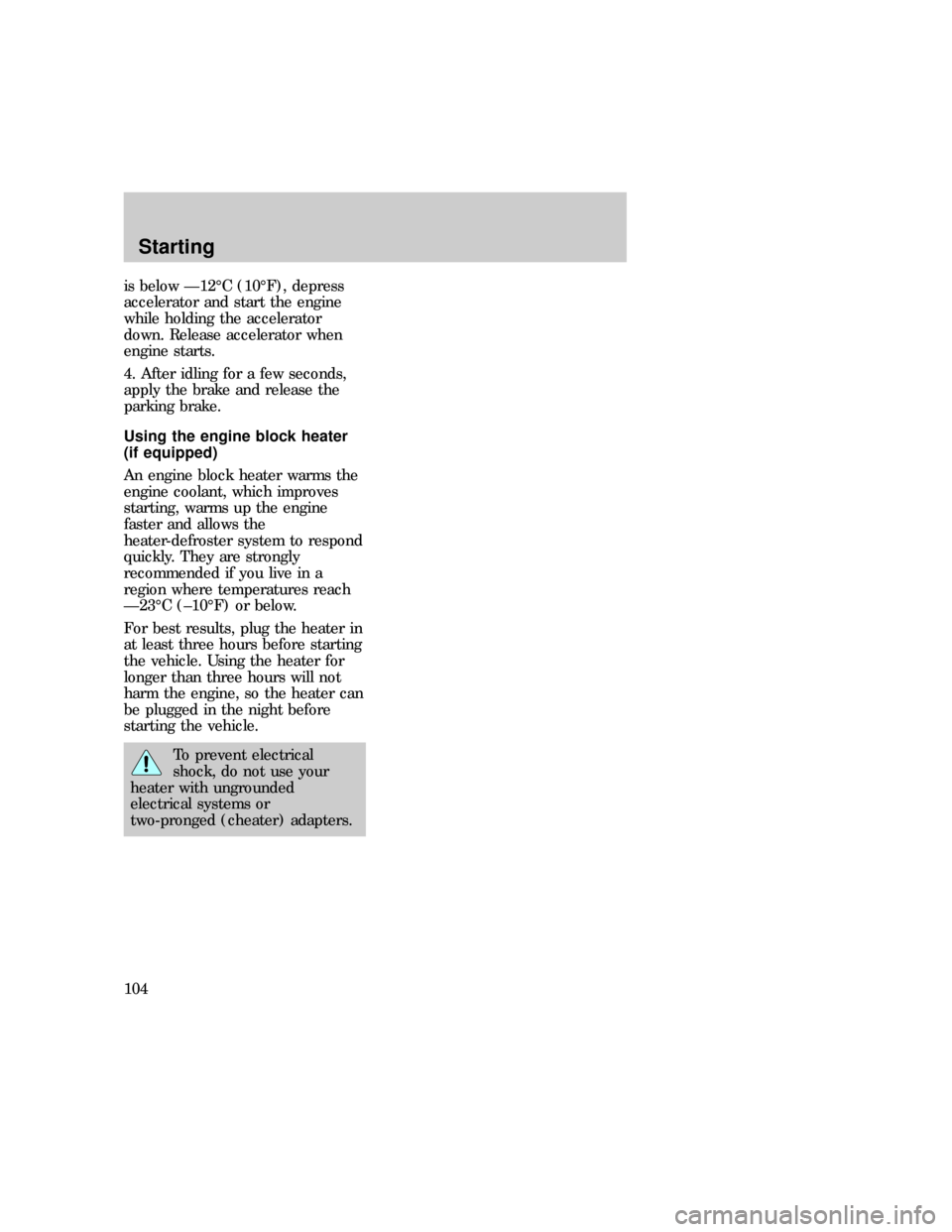
is below Ð12ÉC (10ÉF), depress
accelerator and start the engine
while holding the accelerator
down. Release accelerator when
engine starts.
4. After idling for a few seconds,
apply the brake and release the
parking brake.
Using the engine block heater
(if equipped)
An engine block heater warms the
engine coolant, which improves
starting, warms up the engine
faster and allows the
heater-defroster system to respond
quickly. They are strongly
recommended if you live in a
region where temperatures reach
Ð23ÉC (±10ÉF) or below.
For best results, plug the heater in
at least three hours before starting
the vehicle. Using the heater for
longer than three hours will not
harm the engine, so the heater can
be plugged in the night before
starting the vehicle.
To prevent electrical
shock, do not use your
heater with ungrounded
electrical systems or
two-pronged (cheater) adapters.
com_engine_heater.01
com_ventilation_info.01
Starting
104
Page 107 of 224

Braking with ABS
On vehicles with ABS, the wheels
will not lock and slide when you
press down hard on the brake
pedal. The ABS automatically
releases and reapplies the front
and rear brakes independently
whenever the wheels start to lock.
When this happens, you will feel
the brake pedal pulse. This pulse
may be unfamiliar feeling, but it is
a normal indication that the ABS is
working as designed.
Do not ªpumpº the brake pedal of
vehicles with ABS.
exd_parking_brake
Driving
108
Page 108 of 224
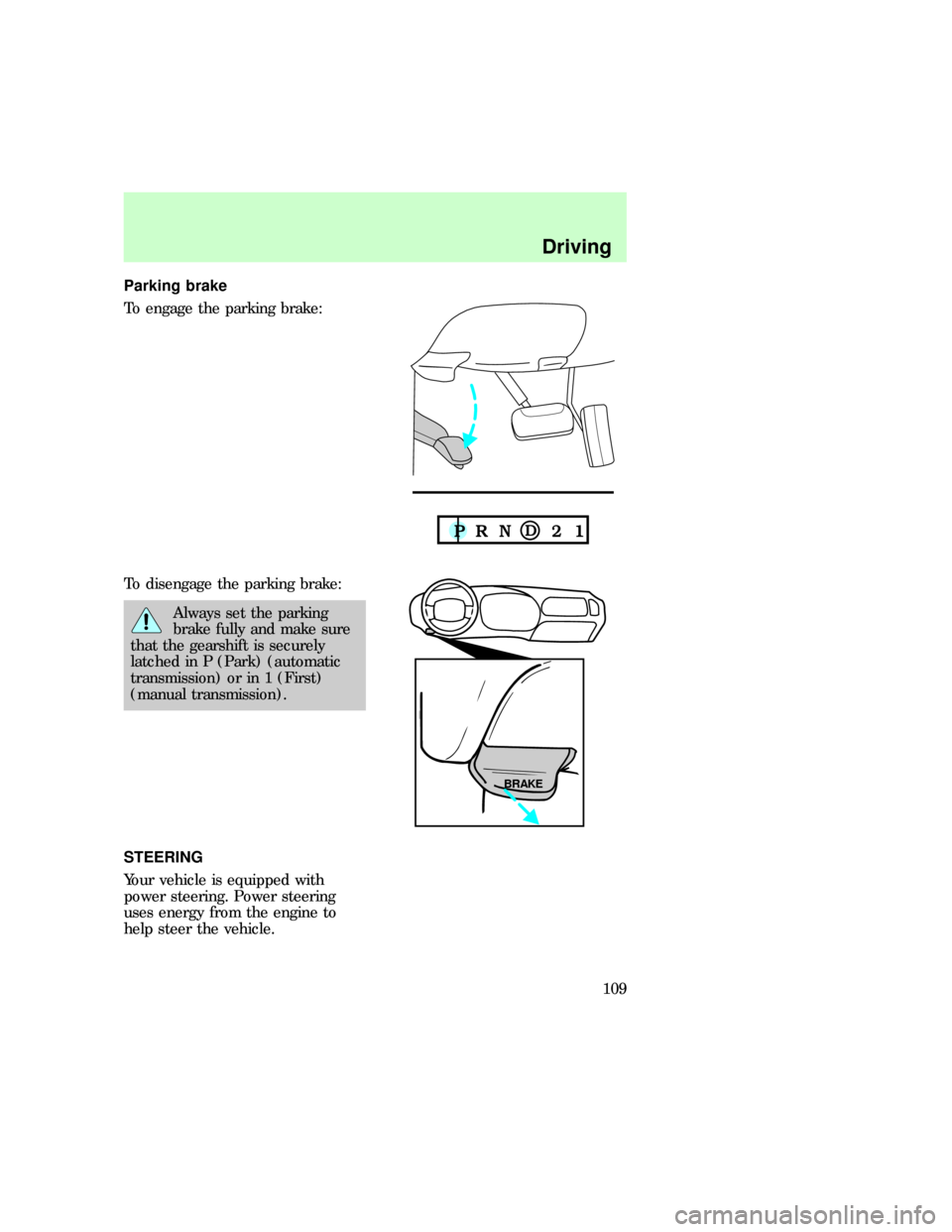
Parking brake
To engage the parking brake:
To disengage the parking brake:
Always set the parking
brake fully and make sure
that the gearshift is securely
latched in P (Park) (automatic
transmission) or in 1 (First)
(manual transmission).
STEERING
Your vehicle is equipped with
power steering. Power steering
uses energy from the engine to
help steer the vehicle.
BRAKE
exd_steering
Driving
109
Page 114 of 224
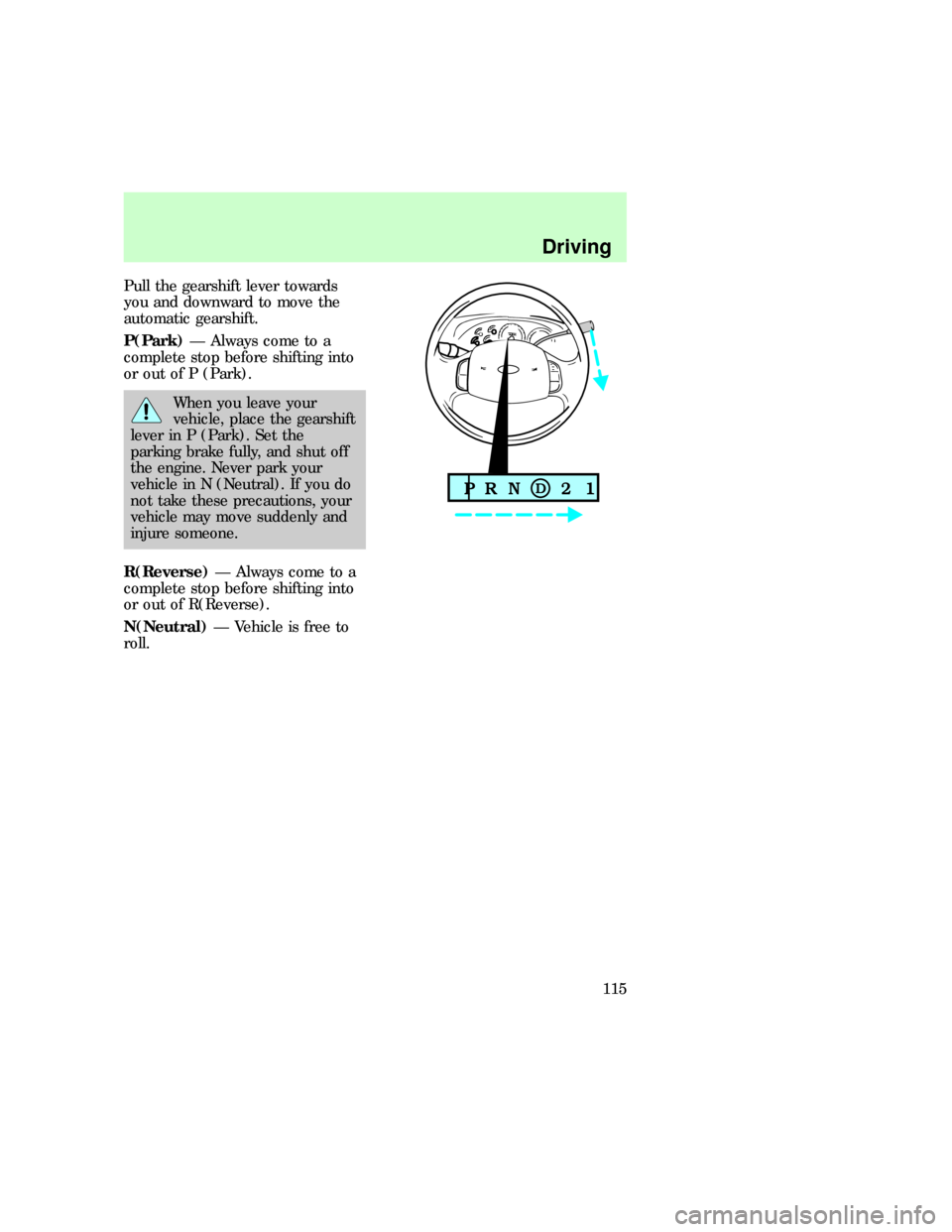
Pull the gearshift lever towards
you and downward to move the
automatic gearshift.
P(Park)Ð Always come to a
complete stop before shifting into
or out of P (Park).
When you leave your
vehicle, place the gearshift
lever in P (Park). Set the
parking brake fully, and shut off
the engine. Never park your
vehicle in N (Neutral). If you do
not take these precautions, your
vehicle may move suddenly and
injure someone.
R(Reverse)Ð Always come to a
complete stop before shifting into
or out of R(Reverse).
N(Neutral)Ð Vehicle is free to
roll.
Driving
115
Page 116 of 224
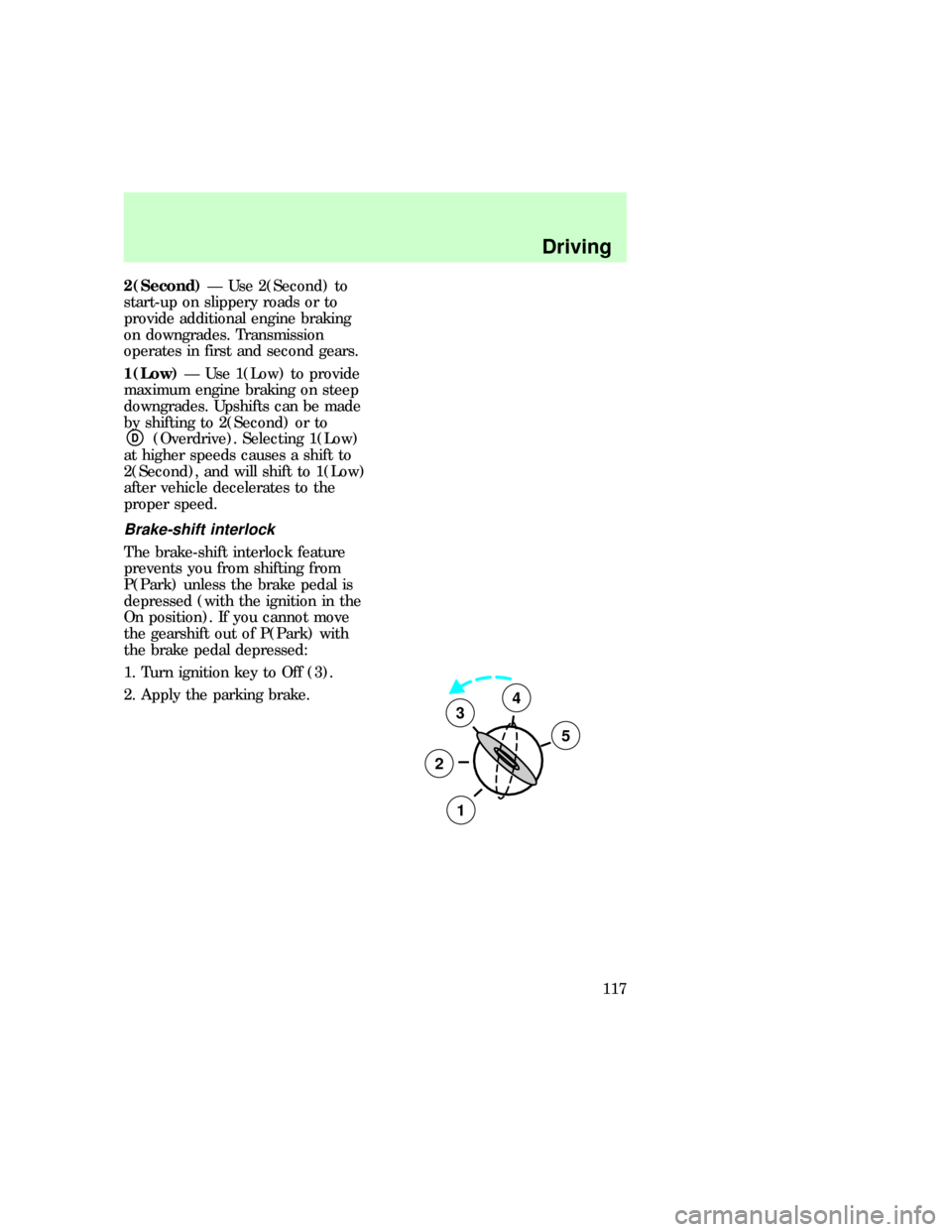
2(Second)Ð Use 2(Second) to
start-up on slippery roads or to
provide additional engine braking
on downgrades. Transmission
operates in first and second gears.
1(Low)Ð Use 1(Low) to provide
maximum engine braking on steep
downgrades. Upshifts can be made
by shifting to 2(Second) or to
D(Overdrive). Selecting 1(Low)
at higher speeds causes a shift to
2(Second), and will shift to 1(Low)
after vehicle decelerates to the
proper speed.
Brake-shift interlock
The brake-shift interlock feature
prevents you from shifting from
P(Park) unless the brake pedal is
depressed (with the ignition in the
On position). If you cannot move
the gearshift out of P(Park) with
the brake pedal depressed:
1. Turn ignition key to Off (3).
2. Apply the parking brake.
3
2
1
5
4
exd_brake_shift_interlock
Driving
117